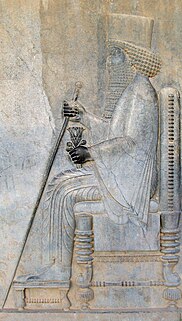
Darius I, commonly known as Darius the Great, was the third Persian King of Kings of the Achaemenid Empire, reigning from 522 BCE until his death in 486 BCE. He ruled the empire at its peak, when it included much of West Asia, parts of the Caucasus, parts of the Balkans, most of the Black Sea coastal regions, Central Asia, as far as the Indus Valley in the far east and portions of north and northeast Africa including Egypt (Mudrâya), eastern Libya, and coastal Sudan.

Artaxerxes II Mnemon was the King of Kings of Persia from 404 BC until his death in 358 BC. He was a son of Darius II and Parysatis.

Achaemenes was an Achaemenid general and satrap of ancient Egypt during the early 5th century BC, at the time of the 27th Dynasty of Egypt.

Arsames was the son of Ariaramnes and perhaps briefly the king of Persia during the Achaemenid dynasty, but he gave up the throne and declared loyalty to Cyrus II of Persia. After this, Arsames most likely retired to his family estate in the Persian heartland of Parsa, and lived out the rest of his long years there peacefully, though he may nominally have exercised the duties of a "lesser king" under the authority of the "Great King". In an inscription allegedly found in Hamadan he is called "king of Persia", but some scholars believe it is a fraud, either modern or ancient. Another attestation of his reign is the Behistun Inscription, where his grandson Darius I lists him among his royal forebears and counts him among the eight kings who preceded him.
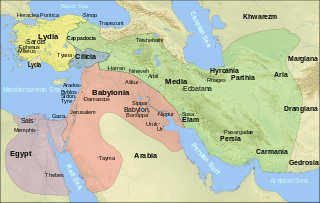
The Late Period of ancient Egypt refers to the last flowering of native Egyptian rulers after the Third Intermediate Period in the 26th Saite Dynasty founded by Psamtik I, but includes the time of Achaemenid Persian rule over Egypt after the conquest by Cambyses II in 525 BC as well. The Late Period existed from 664 BC until 332 BC, following a period of foreign rule by the Nubian 25th dynasty and beginning with a short period of Neo-Assyrian suzerainty, with Psamtik I initially ruling as their vassal. The period ended with the conquests of the Persian Empire by Alexander the Great and establishment of the Ptolemaic dynasty by his general Ptolemy I Soter, one of the Hellenistic diadochi from Macedon in northern Greece. With the Macedonian Greek conquest in the latter half of the 4th century BC, the age of Hellenistic Egypt began.
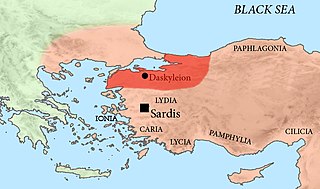
Ariobarzanes, Ariobarzan or spelled as Ario Barzan or Aryo Barzan, perhaps signifying "exalting the Aryans", sometimes known as Ariobarzanes I of Cius, was a Persian Satrap of Phrygia and military commander, leader of an independence revolt, and the first known of the line of rulers of the Greek town of Cius from which were eventually to stem the kings of Pontus in the 3rd century BCE. Ariobarzanes was apparently a cadet member of the Achaemenid dynasty, possibly son of Pharnabazus II, and part of the Pharnacid dynasty which had settled to hold Dascylium of Hellespont in the 470s BCE. Cius is located near Dascylium, and Cius seemingly was a share of family holdings for the branch of Ariobarzanes.

Sophene was a province of the ancient kingdom of Armenia and of the Roman Empire, located in the south-west of the kingdom. The region lies in what is now southeastern Turkey.
The Orontid dynasty, also known by their native name Eruandid or Yervanduni, was a hereditary Armenian dynasty and the rulers of the successor state to the Iron Age kingdom of Urartu (Ararat). The Orontids established their supremacy over Armenia around the time of the Scythian and Median invasion in the 6th century BC.
Samos or Sames was satrap of Commagene, Armenian king of Commagene and Sophene. War between the Seleucid Empire and the Ptolemaic Kingdom seems to have allowed Sames an opportunity for independence for his kingdom. What side he took in the Syrian Wars is unknown as most of the records of that era have been lost, though it is considered likely that he would have supported the Ptolemaic Kingdom against his large and powerful neighbour, the Seleucid Empire.
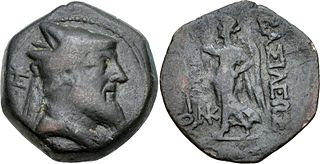
Xerxes was king of Sophene and Commagene from 228 BC to 212 BC. He was the son and successor of Arsames I.
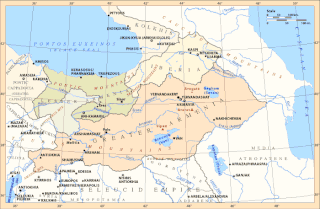
The Satrapy of Armenia (Armenian: Սատրապական Հայաստան Satrapakan Hayastan; Old Persian: Armina or Arminiya, a region controlled by the Orontid Dynasty was one of the satrapies of the Achaemenid Empire in the 6th century BC, which later became an independent kingdom. Its capitals were Tushpa and later Erebuni.
Ptolemaeus was of Iranian descent. Initially satrap of Commagene, he became the first King of Commagene in 163 BC. He belonged to the Orontid Dynasty, founded by Orontes I. Ptolemaeus' father was King Orontes IV of Armenia, son of Arsames I.

The Kingdom of Sophene was a Hellenistic-era political entity situated between ancient Armenia and Syria. Ruled by the Orontid dynasty, the kingdom was culturally mixed, with Iranian and Greek elements being the strongest, along with Armenian, Syrian and Roman influences. Founded around the 3rd century BC the kingdom maintained independence until c. 95 BC when the Artaxiad king Tigranes the Great conquered the territories as part of his empire. Attempts to restore the kingdom were briefly made in 66 BC and 54 AD.

Aryandes was the first Achaemenid satrap of ancient Egypt between the 6th and 5th centuries BCE, during the early 27th Dynasty of Egypt.

Arsames was an Achaemenid satrap of ancient Egypt during the 5th century BC, at the time of the 27th Dynasty of Egypt.

The Pharnacid dynasty was a Persian dynasty that ruled the satrapy of Hellespontine Phrygia under the Achaemenid Dynasty from the 5th until the 4th century BCE. It was founded by Artabazus, son of satrap Pharnaces I, son of Arsames. They were directly related to the Achaemenid dynasty itself. The last member of the dynasty was Pharnabazus III.
Carcathiocerta was a city in Armenian Sophene near the Tigris, identified with the modern town of Eğil. It was the first capital of Sophene until Arsames I founded the new capital Arshamshat around 230 BCE. The Seleucid king Antiochus IV Epiphanes renamed the city into Epiphania. Strabo in his Geography, calls it "The royal city of Sophene". It was assigned to the late Roman province of Mesopotamia. It also bore the names Artagigarta, Baras, Basileon Phrourion, and Ingila. Under the name Ingila, it became a bishopric; no longer the seat of a residential bishop, it remains a titular see of the Roman Catholic Church.

Frataraka is an ancient Persian title, interpreted variously as “leader, governor, forerunner”. It is an epithet or title of a series of rulers in Persis from 3rd to mid 2nd century BC, or alternatively between 295 and 220 BC, at the time of the Seleucid Empire, prior to the Parthian conquest of West Asia and Iran. Studies of frataraka coins are important to historians of this period.

Pherendates was an Achaemenid satrap of ancient Egypt during the 5th century BCE, at the time of the Achaemenid 27th Dynasty of Egypt.

Pharnaces Ι was a son of Arsames. He was a younger brother of Hystaspes, and therefore an uncle of Achaemenid Emperor Darius I, son of Hystaspes. He was the founder of the Pharnacid dynasty that ruled over Hellespontine Phrygia.












